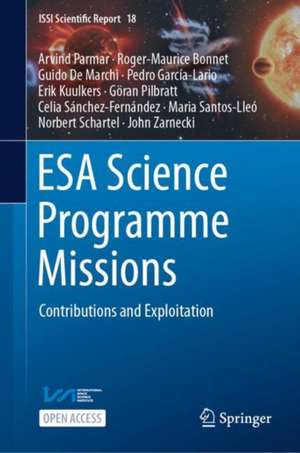ESA Science Programme Missions: Contributions and Exploitation: ISSI Scientific Report Series, cartea 18
Autor Arvind Parmar, Roger-Maurice Bonnet, Guido De Marchi, Pedro García-Lario, Erik Kuulkers, Göran Pilbratt, Celia Sánchez-Fernández, Maria Santos-Lleó, Norbert Schartel, John Zarneckien Limba Engleză Hardback – 11 ian 2025
Finally, we examine the provision of payload elements for ESA’s Science Programme missions. We use the number of payload investigators to give insights into the levels of contribution and exploitation of the different ESA Member States.
This book is open access under a CC BY license.
Preț: 368.27 lei
Nou
Puncte Express: 552
Preț estimativ în valută:
70.47€ • 73.57$ • 58.32£
70.47€ • 73.57$ • 58.32£
Carte disponibilă
Livrare economică 11-17 martie
Livrare express 01-07 martie pentru 44.74 lei
Preluare comenzi: 021 569.72.76
Specificații
ISBN-13: 9783031690037
ISBN-10: 3031690036
Ilustrații: X, 157 p. 89 illus., 85 illus. in color.
Dimensiuni: 155 x 235 mm
Greutate: 0.52 kg
Ediția:2024
Editura: Springer Nature Switzerland
Colecția Springer
Seria ISSI Scientific Report Series
Locul publicării:Cham, Switzerland
ISBN-10: 3031690036
Ilustrații: X, 157 p. 89 illus., 85 illus. in color.
Dimensiuni: 155 x 235 mm
Greutate: 0.52 kg
Ediția:2024
Editura: Springer Nature Switzerland
Colecția Springer
Seria ISSI Scientific Report Series
Locul publicării:Cham, Switzerland
Cuprins
1 The ESA Science Programme.- 2 ESA Mission Publications and their Impact.- 3 Payload Provision to the ESA Science Programme.- 4 XMM-Newton Observing Time Proposals.- 5 INTEGRAL Observing Time Proposals.- 6 Herschel Observing Time Proposals.- 7 Conclusions.
Notă biografică
Dr. Parmar obtained his PhD in X-ray astronomy in 1981 from MSSL, University College London (UCL). He joined ESA in 1982 to work on the EXOSAT mission before becoming the study and project scientist and instrument and mission manager for a number of high-energy astronomy missions. In 2009 he became Head of ESA’s Astronomy Science Operations Division. Between 2012 and 2020 he was the ESA Coordinator for Astronomy and Fundamental Physics. From 2013-2020 he combined this position with being the Head of the ESA Science Support Office, which is the home of ESA’s Science Directorate study and project scientists. In 2020, he retired from ESA. In 2023 he was awarded an honorary professorship at UCL and in 2024 he became the treasurer of the Royal Astronomical Society. He has 408 scientific publications of which 181 are peer reviewed with 13,400 citations.
Textul de pe ultima copertă
This work got its start by trying to answer the question "how do you evaluate the scientific performance of the ESA's Science Programme missions?" For many years, the decision makers responsible for the content of the ESA Science Programme have been provided with information for each mission including, but not limited to, the number of publications published, the number of publications that are highly cited, the total number of citations used, various statistical metrics and the number of unique author names. However, this reporting only provides snapshots of these missions and was not widely distributed.
In this book, we report on a systematic study of these metrics and their evolution with time to provide insights into mission successes and the communities exploiting the data provided by the Science Programme’s missions. In addition, we examine the outcomes of the announcements of observing opportunities for ESA’s observatory missions, INTEGRAL, Herschel and XMM-Newton to provide insights into the evolutions of the user communities with time, location and gender.
Finally, we examine the provision of payload elements for ESA’s Science Programme missions. We use the number of payload investigators to give insights into the levels of contribution and exploitation of the different ESA Member States.
This book is open access under a CC BY license.
In this book, we report on a systematic study of these metrics and their evolution with time to provide insights into mission successes and the communities exploiting the data provided by the Science Programme’s missions. In addition, we examine the outcomes of the announcements of observing opportunities for ESA’s observatory missions, INTEGRAL, Herschel and XMM-Newton to provide insights into the evolutions of the user communities with time, location and gender.
Finally, we examine the provision of payload elements for ESA’s Science Programme missions. We use the number of payload investigators to give insights into the levels of contribution and exploitation of the different ESA Member States.
This book is open access under a CC BY license.
Caracteristici
The first systematic study of the publications from the ESA Science Programme’s missions Discusses the contributions and outcomes from the ESA Science Programme Reports on publication metrics and their evolution with time to provide insights into mission successes This book is open access, which means that you have free and unlimited access









